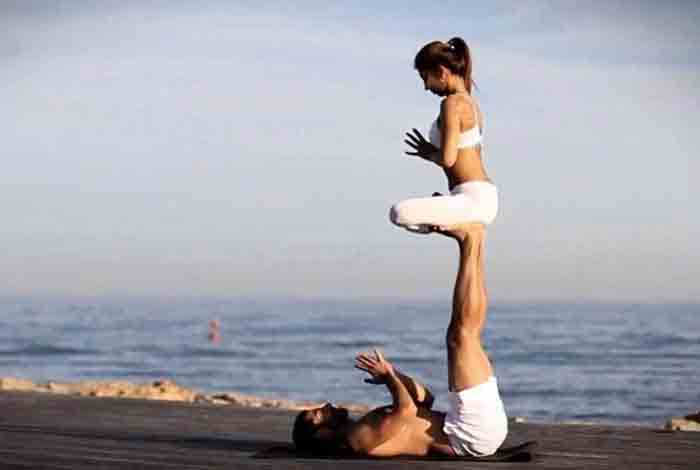
Acroyoga – Latest Fitness Trend Combining Yoga, Acrobatics and Exercise

You’ve lately been seeing Acroyoga all over your Instagram feed. And, let us tell it is a lot more than just a trend on social media. It derives its inspiration from the traditional yoga, acrobatics, and other therapies like Thai massage.
Many people around the world have been practicing acroyoga. Yoga is done alone and it is an internal practice. Conversely, acroyoga is external and is done socially with a partner. It’s like play for adults and playing is relieving. The poses may scare the hell out of you, but they are really beneficial.
Working of Acroyoga
For every pose, there are three to four individuals involved. These are:
1. Flyer
This is the one, who remains balanced in the air, twisted up and on top of the other person. The flyer balances the pose with strength and creates elevation in the pose while the partner forms a stable base to provide support to the flyer.
2. Base
He is the foundation on which the other partner is able to make the balance. To form the base, the partner has to stack the bones and stay steady to support the other one.
3. Spotter (s)
They are an important part of the practice. Their work is to support both the flyer and the base and give assistance throughout the formation of the pose. There may be either one or two spotters present.
Comparison with Other Types of Yoga
Traditional Yoga started thousands of years back. It revolves around a limited number of poses and is often a solo activity with emphasis on regulated and controlled breathing. There are many types of yoga involving the same types of practice. This is true for Acroyoga only in part, but not completely.
Acroyoga is a combination of yoga and acrobatics. But, it is far from the traditional yoga. It is an improvised version of the same. Traditional yoga can be seen in acroyoga poses as there are many positions taken directly from the traditional yoga but, it is more like partner gymnastics.
Benefits of Acroyoga
This is one way to exercise with friends, and taking photos for sharing those seemingly impossible poses. There are other benefits too that are discussed below:
1. Skin-to-Skin Contact
Generally, physical touch is for sexual partners. But, with acroyoga you can develop intimacy with others, which is safe, playful and platonic. It is the same feeling as if you are playing, horsing and goofing around with your friends.
2. Building of Trust
Establishing trust is an important component of acroyoga. While you are holding someone high up in the air, or being held yourself and are spotting your friends to make sure they do not get injured. It is about keeping everyone safe. Some people slowly develop trust while others take no time. Different comfort levels have a place in the practice.
3. Communication
This practice requires mindful communication. The poses are difficult and disorienting, and each partner experiences it in a different way. So, having a hold on different styles of communication is important. Thus, the individuals need to evaluate how they speak to others even if they are frustrated and doubtful about the results.

Who All Can Perform Acroyoga?
Broadly, anyone can perform Acroyoga. The environment should be progressive, method based and safe. This requires team effort, so the individuals have to adjust in accordance with their partners. This makes the experience tailor-made for the participants. There’s nothing like perfect situation or a perfect body, hence everyone can perform to see what happens.
Acroyoga and Social Media
Acroyoga is a comparatively new practice. So, its proponents are largely dependent on social media for its promotion and connecting like-minded people.
Videos explaining ‘how to do Acroyoga’ have been there on YouTube. With time, more and more people started looking out for trainings from experienced teachers and began connecting on social media sites, and from there, it spread like fire.
In the Acroyoga community, jams are organized regularly, where people in large numbers show up and practice in an unstructured environment.










